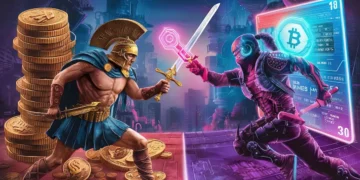In a market dominated by hype, it’s easy to miss the tokens quietly delivering real value, and especially those trading under $1. But in 2025, as blockchain use grows across industries, these low-cost tokens are powering platforms, solving real problems, and gaining users worldwide.
This article highlights six under-$1 tokens with real utility, adoption data, and growing ecosystems worth watching.
What Are Utility Tokens?
Utility tokens serve a specific function within a blockchain network, such as powering transactions, enabling governance, or unlocking services. Their value comes from usage, not speculation. As more users interact with the platform, demand for the token rises. This ties price potential directly to real-world activity, making utility tokens key to blockchain’s future.
Why Focus on Tokens Under $1?
Psychology plays a large role in how retail investors perceive crypto assets. Sub-$1 tokens often seem more accessible or full of upside, even though their overall valuation depends on market cap and supply. But historically, many investors have seen strong returns by entering quality projects early—before widespread recognition.
Selection Criteria
That said, a low price alone isn’t enough. The tokens covered here combine their affordability with solid fundamentals.
To filter through this crowded market, we focused on:
- Price: Under $1 as of August 2025.
- Utility: Real-world use cases and active users.
- Adoption: Clear metrics or partnerships showing traction.
- Diversity: Coverage of multiple sectors like payments, storage, and identity.
- Maturity: A mix of established players and emerging innovators.
These traits are what we believe separate short-term hype from long-term winners. Let’s see who made the cut.
1. Cardano (ADA) – A Research-Driven Platform with a Growing Ecosystem
Sector: Smart Contracts / DeFi / Digital Identity
Cardano is known for its academically reviewed approach to blockchain design, focusing on sustainability, scalability, and security. Its two-layer architecture and peer-reviewed proof-of-stake consensus (Ouroboros) are designed for energy efficiency and long-term resilience.
ADA powers activity across Cardano’s growing ecosystem, including DeFi, governance, and staking. Since the Goguen upgrade, adoption has expanded across multiple fronts:
- DeFi platforms: Minswap and Liqwid lead the ecosystem’s DEX and lending activity.
- NFTs and marketplaces: JPG Store serves as a hub for NFT trading and creator engagement.
- Digital identity: A national ID solution was rolled out in Ethiopia’s education system.
- Cross-chain experiments: Interoperability tests began with NEAR Protocol using “Intents.”
- Scalability infrastructure: Hydra (a Layer 2 scaling solution) and Mithril (state syncing) improve network speed and accessibility.
With Project Catalyst funding thousands of proposals and frequent protocol upgrades, we see Cardano laying one of the most solid foundations in the space for real-world utility.
ADA: Price History & 2025 Outlook
- All-Time High (ATH): $3.09 (September 2021)
- January 2025 Price: ~$0.99
Current Price:
ADA currently trades about 76% below its ATH and nearly 25% below its January 2025 level. In our view, that leaves plenty of room for upside, especially as Cardano continues to mature into a full-featured platform with growing user activity and developer interest.
Analysts forecast ADA trading between $0.90 and $1.50 in 2025, with bullish scenarios targeting $3+. Explore our Cardano (ADA) price prediction and see how far it could climb in the next bull run.
2. VeChain (VET) – Supply Chain Management & an Anti-Counterfeiting Powerhouse
Price widget TradingView
Sector: Supply Chain / ESG / Product Authentication
VeChain has long focused on real-world logistics, offering tools for supply chain transparency and anti-counterfeiting. Its dual-token model (VET + VTHO) keeps transaction costs low and predictable, which is critical for enterprise adoption.
Enterprises and governments already use VeChain to:
- Track food supply chains: Walmart China uses it to monitor product movement from farm to shelf.
- Log vehicle service history: BMW tested VeChain for tamper-proof maintenance records via VerifyCar.
- Streamline compliance and ESG reporting: DNV applies it to digitize certifications and sustainability data.
- Pilot digital maintenance records: Renault explored using it for blockchain-based service logs.
- Issue carbon credits: San Marino launched a national incentive system powered by VeChain.
Beyond retail and automotive, VeChain is also tackling carbon tracking, healthcare logistics, and sustainability compliance. VeChain ToolChain enables businesses to deploy blockchain solutions without needing deep technical expertise.
Despite a low unit price, VET’s integrations with enterprise partners and government agencies make it one of the most battle-tested utility tokens, and many believe it’s still significantly undervalued. We’ve seen time and again: the tokens that survive bear markets are the ones solving real problems.
VET: Price History & 2025 Outlook
- All-Time High (ATH): $0.28 (April 2021)
- January 2025 Price: ~$0.034
Current Price:
VET is trading around 88% below its ATH and down roughly 15% from January 2025 levels. VeChain’s real-world momentum contrasts sharply with its low valuation, setting up a potential value correction.
Analyst projections place VET between $0.04 and $0.08 in 2025, with more aggressive forecasts aiming for a return to the $0.20+ range.
3. Basic Attention Token (BAT) – Reinventing Digital Advertising
Price widget TradingView
Sector: Digital Advertising / Web3 Browsing
BAT powers the Brave Browser, which has over 90 million monthly active users, and aims to fix online advertising by aligning incentives between users, advertisers, and content creators. Brave users can opt into privacy-respecting ads and get paid in BAT for their attention.
Use cases include:
- User rewards: you can earn BAT for viewing ads.
- Tipping & contributions: support YouTubers, bloggers, or sites via Brave Rewards.
- Advertiser payments: major brands (Amazon, Verizon, Binance) run ad campaigns paid in BAT.
- Brave Wallet: integrates swaps, supports BAT for gas fees on supported networks.
With rising concerns around ad tracking and privacy, BAT positions itself as a Web3-native alternative to surveillance-based ad models.
BAT: Price History & 2025 Outlook
- All-Time High (ATH): $1.90 (November 2021)
- January 2025 Price: ~$0.30
Current Price:
BAT currently trades over 80% below its ATH and slightly down from its January level. As Brave scales, BAT may see renewed interest and value alignment.
Price forecasts for BAT in 2025 range between $0.35 and $0.70, with long-term bulls pointing to the $1+ zone if adoption continues. See what’s ahead for BAT in our Basic Attention Token price prediction.
4. Hedera (HBAR) – Enterprise-Focused DLT with Trusted Governance
Price widget TradingView
Sector: Enterprise DLT / Tokenization / ESG
Hedera Hashgraph is not a traditional blockchain. It uses a directed acyclic graph (DAG) consensus called Hashgraph. This allows it to process over 10,000 transactions per second, with near-instant finality and predictable, low fees (~$0.001 per tx).
HBAR is the native token, used for paying fees, staking, and smart contracts. Its architecture makes it ideal for enterprises and governments seeking reliable, high-throughput infrastructure.
Key integrations and use cases include:
- Decentralized governance at scale: global companies like Google, IBM, Boeing, and LG sit on Hedera’s 27-member council.
- Enterprise stablecoin infrastructure: IBM built a stablecoin on Hedera for hybrid blockchain deployments.
- Supply chain verification: Avery Dennison’s atma.io platform uses Hedera to authenticate product data.
- Pharmaceutical traceability: The U.S. State Department and DLA Piper piloted Hedera to track pharmaceutical supply chains.
- Digital credential systems: Dubai’s government uses Hedera to securely verify education records.
HBAR’s enterprise focus is further supported by rising transaction volumes. For investors looking at tokenized assets, ESG tracking, and public-private hybrid solutions, Hedera offers one of the most mature and scalable platforms on the market.
HBAR: Price History & 2025 Outlook
- All-Time High (ATH): $0.57 (September 2021)
- January 2025 Price: ~$0.086
Current Price:
HBAR trades about 85% under its ATH and roughly 12% lower than in January. The token still trades at a steep discount relative to Hedera’s institutional activity and network speed.
Analyst predictions vary, with most placing HBAR between $0.10 and $0.25 in 2025, while more bullish voices call for a breakout toward the $0.50 mark. Our Hedera (HBAR) price prediction covers where the asset’s price might go next.
5. Stellar (XLM) – Fast, Low-Cost Global Payments & Financial Inclusion
Price widget TradingView
Sector: Cross-Border Payments / Financial Inclusion
Stellar is purpose-built for fast, affordable cross-border payments. Its core mission is financial inclusion, enabling users (especially in underbanked regions) to send and receive money in seconds, with fees that are often a fraction of a cent.
XLM facilitates currency conversion on the Stellar network, which includes a decentralized exchange (SDEX) and a system of “anchors” that connect fiat and crypto. Users can send local currency in one country and receive local currency in another—XLM serves as the bridge asset.
Real-world use cases include:
- Cross-border banking infrastructure: IBM’s World Wire uses Stellar to process international payments across 50+ countries.
- Retail remittances with stablecoins: MoneyGram enables USDC transfers and cash-out at over 30,000 global locations.
- Humanitarian aid distribution: UNHCR delivered over $10 million in aid to Ukrainian refugees via Stellar wallets.
- Stablecoin issuance and CBDC pilots: Stellar supports USDC and collaborated with Ukraine’s government on a digital Hryvnia pilot.
- Fiat-crypto bridging: Anchors on the network connect local fiat currencies to Stellar-based digital assets.
With a growing ecosystem and a strong focus on solving real problems, XLM is a leading example of blockchain’s utility in global finance.
XLM: Price History & 2025 Outlook
- All-Time High (ATH): $0.87 (January 2018)
- January 2025 Price: ~$0.13
Current Price:
XLM is trading 85%+ below its ATH and about 18% below its January 2025 level. We believe very few projects can claim real-world humanitarian impact at this scale, and Stellar definitely deserves more credit for it. With so many impactful integrations, XLM may be overdue for a price correction.
Predictions for XLM in 2025 range from $0.15 to $0.35, with optimistic outlooks targeting $0.50+ if global stablecoin infrastructure expands. We mapped out the next moves for Stellar—see the full XLM price prediction here.
6. Filecoin (FIL) – The Backbone of Decentralized Storage
Price widget TradingView
Sector: Decentralized Storage / Web3 Infrastructure
Filecoin provides a decentralized solution to digital storage, allowing users to rent out unused hard drive space while others pay to store data across a distributed network. Unlike centralized cloud providers, Filecoin offers censorship resistance and cost efficiency, both key priorities in a Web3 future.
Filecoin is already in use across:
- Web3 platforms: storing NFT metadata and DeFi-related data.
- Distributed file systems: enhancing IPFS with decentralized permanence.
- Academia and government: archiving scientific and public records for transparency and accessibility.
Filecoin is also expanding into smart contract capabilities via the Filecoin Virtual Machine (FVM), enabling programmable storage applications. As concerns over centralization and censorship in cloud storage grow, Filecoin is emerging as a foundational layer for the decentralized internet.
Filecoin (FIL) Price Snapshot
- All-Time High (ATH): $236 (April 2021)
- January 2025 Price: ~$5.80
Current Price:
FIL is trading more than 97% below its ATH and nearly 30% down from January’s level. Despite sharp price compression, Filecoin’s growing role in Web3 infrastructure suggests long-term upside.
Most analysts forecast FIL between $6 and $12 in 2025, with some calling for $20+ if Web3 storage becomes a breakout sector. Explore our Filecoin (FIL) price prediction to see where things could go.
Check out what’s ahead for Filecoin in our FIL price prediction.
Why This Basket Fits the 2025 Bull Run
Each of these six tokens—ADA, VET, BAT, HBAR, XLM, and FIL—solves a different problem, yet shares one trait: they all power ecosystems that are already working. In a market that often chases narratives, these projects have quietly built platforms with measurable usage, active communities, and real-world integrations.
They also cover a wide spectrum of use cases, from identity and DeFi to advertising, logistics, remittances, and data storage. This diversity not only mitigates risk but also increases the likelihood of at least one or two sectors booming during the next bull run.
If 2025 becomes the year where utility finally outshines speculation, this mix of under-$1 tokens may outperform more narrative-driven bets. The fundamentals are already in place—the next phase is broader recognition.
For those positioning ahead of the next wave, this basket offers more than just upside. It offers use you can verify, adoption you can track, and networks already doing the work.
Disclaimer: Please note that the contents of this article are not financial or investing advice. The information provided in this article is the author’s opinion only and should not be considered as offering trading or investing recommendations. We do not make any warranties about the completeness, reliability and accuracy of this information. The cryptocurrency market suffers from high volatility and occasional arbitrary movements. Any investor, trader, or regular crypto users should research multiple viewpoints and be familiar with all local regulations before committing to an investment.
In a market dominated by hype, it’s easy to miss the tokens quietly delivering real value, and especially those trading under $1. But in 2025, as blockchain use grows across industries, these low-cost tokens are powering platforms, solving real problems, and gaining users worldwide.
This article highlights six under-$1 tokens with real utility, adoption data, and growing ecosystems worth watching.
What Are Utility Tokens?
Utility tokens serve a specific function within a blockchain network, such as powering transactions, enabling governance, or unlocking services. Their value comes from usage, not speculation. As more users interact with the platform, demand for the token rises. This ties price potential directly to real-world activity, making utility tokens key to blockchain’s future.
Why Focus on Tokens Under $1?
Psychology plays a large role in how retail investors perceive crypto assets. Sub-$1 tokens often seem more accessible or full of upside, even though their overall valuation depends on market cap and supply. But historically, many investors have seen strong returns by entering quality projects early—before widespread recognition.
Selection Criteria
That said, a low price alone isn’t enough. The tokens covered here combine their affordability with solid fundamentals.
To filter through this crowded market, we focused on:
- Price: Under $1 as of August 2025.
- Utility: Real-world use cases and active users.
- Adoption: Clear metrics or partnerships showing traction.
- Diversity: Coverage of multiple sectors like payments, storage, and identity.
- Maturity: A mix of established players and emerging innovators.
These traits are what we believe separate short-term hype from long-term winners. Let’s see who made the cut.
1. Cardano (ADA) – A Research-Driven Platform with a Growing Ecosystem
Sector: Smart Contracts / DeFi / Digital Identity
Cardano is known for its academically reviewed approach to blockchain design, focusing on sustainability, scalability, and security. Its two-layer architecture and peer-reviewed proof-of-stake consensus (Ouroboros) are designed for energy efficiency and long-term resilience.
ADA powers activity across Cardano’s growing ecosystem, including DeFi, governance, and staking. Since the Goguen upgrade, adoption has expanded across multiple fronts:
- DeFi platforms: Minswap and Liqwid lead the ecosystem’s DEX and lending activity.
- NFTs and marketplaces: JPG Store serves as a hub for NFT trading and creator engagement.
- Digital identity: A national ID solution was rolled out in Ethiopia’s education system.
- Cross-chain experiments: Interoperability tests began with NEAR Protocol using “Intents.”
- Scalability infrastructure: Hydra (a Layer 2 scaling solution) and Mithril (state syncing) improve network speed and accessibility.
With Project Catalyst funding thousands of proposals and frequent protocol upgrades, we see Cardano laying one of the most solid foundations in the space for real-world utility.
ADA: Price History & 2025 Outlook
- All-Time High (ATH): $3.09 (September 2021)
- January 2025 Price: ~$0.99
Current Price:
ADA currently trades about 76% below its ATH and nearly 25% below its January 2025 level. In our view, that leaves plenty of room for upside, especially as Cardano continues to mature into a full-featured platform with growing user activity and developer interest.
Analysts forecast ADA trading between $0.90 and $1.50 in 2025, with bullish scenarios targeting $3+. Explore our Cardano (ADA) price prediction and see how far it could climb in the next bull run.
2. VeChain (VET) – Supply Chain Management & an Anti-Counterfeiting Powerhouse
Price widget TradingView
Sector: Supply Chain / ESG / Product Authentication
VeChain has long focused on real-world logistics, offering tools for supply chain transparency and anti-counterfeiting. Its dual-token model (VET + VTHO) keeps transaction costs low and predictable, which is critical for enterprise adoption.
Enterprises and governments already use VeChain to:
- Track food supply chains: Walmart China uses it to monitor product movement from farm to shelf.
- Log vehicle service history: BMW tested VeChain for tamper-proof maintenance records via VerifyCar.
- Streamline compliance and ESG reporting: DNV applies it to digitize certifications and sustainability data.
- Pilot digital maintenance records: Renault explored using it for blockchain-based service logs.
- Issue carbon credits: San Marino launched a national incentive system powered by VeChain.
Beyond retail and automotive, VeChain is also tackling carbon tracking, healthcare logistics, and sustainability compliance. VeChain ToolChain enables businesses to deploy blockchain solutions without needing deep technical expertise.
Despite a low unit price, VET’s integrations with enterprise partners and government agencies make it one of the most battle-tested utility tokens, and many believe it’s still significantly undervalued. We’ve seen time and again: the tokens that survive bear markets are the ones solving real problems.
VET: Price History & 2025 Outlook
- All-Time High (ATH): $0.28 (April 2021)
- January 2025 Price: ~$0.034
Current Price:
VET is trading around 88% below its ATH and down roughly 15% from January 2025 levels. VeChain’s real-world momentum contrasts sharply with its low valuation, setting up a potential value correction.
Analyst projections place VET between $0.04 and $0.08 in 2025, with more aggressive forecasts aiming for a return to the $0.20+ range.
3. Basic Attention Token (BAT) – Reinventing Digital Advertising
Price widget TradingView
Sector: Digital Advertising / Web3 Browsing
BAT powers the Brave Browser, which has over 90 million monthly active users, and aims to fix online advertising by aligning incentives between users, advertisers, and content creators. Brave users can opt into privacy-respecting ads and get paid in BAT for their attention.
Use cases include:
- User rewards: you can earn BAT for viewing ads.
- Tipping & contributions: support YouTubers, bloggers, or sites via Brave Rewards.
- Advertiser payments: major brands (Amazon, Verizon, Binance) run ad campaigns paid in BAT.
- Brave Wallet: integrates swaps, supports BAT for gas fees on supported networks.
With rising concerns around ad tracking and privacy, BAT positions itself as a Web3-native alternative to surveillance-based ad models.
BAT: Price History & 2025 Outlook
- All-Time High (ATH): $1.90 (November 2021)
- January 2025 Price: ~$0.30
Current Price:
BAT currently trades over 80% below its ATH and slightly down from its January level. As Brave scales, BAT may see renewed interest and value alignment.
Price forecasts for BAT in 2025 range between $0.35 and $0.70, with long-term bulls pointing to the $1+ zone if adoption continues. See what’s ahead for BAT in our Basic Attention Token price prediction.
4. Hedera (HBAR) – Enterprise-Focused DLT with Trusted Governance
Price widget TradingView
Sector: Enterprise DLT / Tokenization / ESG
Hedera Hashgraph is not a traditional blockchain. It uses a directed acyclic graph (DAG) consensus called Hashgraph. This allows it to process over 10,000 transactions per second, with near-instant finality and predictable, low fees (~$0.001 per tx).
HBAR is the native token, used for paying fees, staking, and smart contracts. Its architecture makes it ideal for enterprises and governments seeking reliable, high-throughput infrastructure.
Key integrations and use cases include:
- Decentralized governance at scale: global companies like Google, IBM, Boeing, and LG sit on Hedera’s 27-member council.
- Enterprise stablecoin infrastructure: IBM built a stablecoin on Hedera for hybrid blockchain deployments.
- Supply chain verification: Avery Dennison’s atma.io platform uses Hedera to authenticate product data.
- Pharmaceutical traceability: The U.S. State Department and DLA Piper piloted Hedera to track pharmaceutical supply chains.
- Digital credential systems: Dubai’s government uses Hedera to securely verify education records.
HBAR’s enterprise focus is further supported by rising transaction volumes. For investors looking at tokenized assets, ESG tracking, and public-private hybrid solutions, Hedera offers one of the most mature and scalable platforms on the market.
HBAR: Price History & 2025 Outlook
- All-Time High (ATH): $0.57 (September 2021)
- January 2025 Price: ~$0.086
Current Price:
HBAR trades about 85% under its ATH and roughly 12% lower than in January. The token still trades at a steep discount relative to Hedera’s institutional activity and network speed.
Analyst predictions vary, with most placing HBAR between $0.10 and $0.25 in 2025, while more bullish voices call for a breakout toward the $0.50 mark. Our Hedera (HBAR) price prediction covers where the asset’s price might go next.
5. Stellar (XLM) – Fast, Low-Cost Global Payments & Financial Inclusion
Price widget TradingView
Sector: Cross-Border Payments / Financial Inclusion
Stellar is purpose-built for fast, affordable cross-border payments. Its core mission is financial inclusion, enabling users (especially in underbanked regions) to send and receive money in seconds, with fees that are often a fraction of a cent.
XLM facilitates currency conversion on the Stellar network, which includes a decentralized exchange (SDEX) and a system of “anchors” that connect fiat and crypto. Users can send local currency in one country and receive local currency in another—XLM serves as the bridge asset.
Real-world use cases include:
- Cross-border banking infrastructure: IBM’s World Wire uses Stellar to process international payments across 50+ countries.
- Retail remittances with stablecoins: MoneyGram enables USDC transfers and cash-out at over 30,000 global locations.
- Humanitarian aid distribution: UNHCR delivered over $10 million in aid to Ukrainian refugees via Stellar wallets.
- Stablecoin issuance and CBDC pilots: Stellar supports USDC and collaborated with Ukraine’s government on a digital Hryvnia pilot.
- Fiat-crypto bridging: Anchors on the network connect local fiat currencies to Stellar-based digital assets.
With a growing ecosystem and a strong focus on solving real problems, XLM is a leading example of blockchain’s utility in global finance.
XLM: Price History & 2025 Outlook
- All-Time High (ATH): $0.87 (January 2018)
- January 2025 Price: ~$0.13
Current Price:
XLM is trading 85%+ below its ATH and about 18% below its January 2025 level. We believe very few projects can claim real-world humanitarian impact at this scale, and Stellar definitely deserves more credit for it. With so many impactful integrations, XLM may be overdue for a price correction.
Predictions for XLM in 2025 range from $0.15 to $0.35, with optimistic outlooks targeting $0.50+ if global stablecoin infrastructure expands. We mapped out the next moves for Stellar—see the full XLM price prediction here.
6. Filecoin (FIL) – The Backbone of Decentralized Storage
Price widget TradingView
Sector: Decentralized Storage / Web3 Infrastructure
Filecoin provides a decentralized solution to digital storage, allowing users to rent out unused hard drive space while others pay to store data across a distributed network. Unlike centralized cloud providers, Filecoin offers censorship resistance and cost efficiency, both key priorities in a Web3 future.
Filecoin is already in use across:
- Web3 platforms: storing NFT metadata and DeFi-related data.
- Distributed file systems: enhancing IPFS with decentralized permanence.
- Academia and government: archiving scientific and public records for transparency and accessibility.
Filecoin is also expanding into smart contract capabilities via the Filecoin Virtual Machine (FVM), enabling programmable storage applications. As concerns over centralization and censorship in cloud storage grow, Filecoin is emerging as a foundational layer for the decentralized internet.
Filecoin (FIL) Price Snapshot
- All-Time High (ATH): $236 (April 2021)
- January 2025 Price: ~$5.80
Current Price:
FIL is trading more than 97% below its ATH and nearly 30% down from January’s level. Despite sharp price compression, Filecoin’s growing role in Web3 infrastructure suggests long-term upside.
Most analysts forecast FIL between $6 and $12 in 2025, with some calling for $20+ if Web3 storage becomes a breakout sector. Explore our Filecoin (FIL) price prediction to see where things could go.
Check out what’s ahead for Filecoin in our FIL price prediction.
Why This Basket Fits the 2025 Bull Run
Each of these six tokens—ADA, VET, BAT, HBAR, XLM, and FIL—solves a different problem, yet shares one trait: they all power ecosystems that are already working. In a market that often chases narratives, these projects have quietly built platforms with measurable usage, active communities, and real-world integrations.
They also cover a wide spectrum of use cases, from identity and DeFi to advertising, logistics, remittances, and data storage. This diversity not only mitigates risk but also increases the likelihood of at least one or two sectors booming during the next bull run.
If 2025 becomes the year where utility finally outshines speculation, this mix of under-$1 tokens may outperform more narrative-driven bets. The fundamentals are already in place—the next phase is broader recognition.
For those positioning ahead of the next wave, this basket offers more than just upside. It offers use you can verify, adoption you can track, and networks already doing the work.
Disclaimer: Please note that the contents of this article are not financial or investing advice. The information provided in this article is the author’s opinion only and should not be considered as offering trading or investing recommendations. We do not make any warranties about the completeness, reliability and accuracy of this information. The cryptocurrency market suffers from high volatility and occasional arbitrary movements. Any investor, trader, or regular crypto users should research multiple viewpoints and be familiar with all local regulations before committing to an investment.





















































































x1ev4c